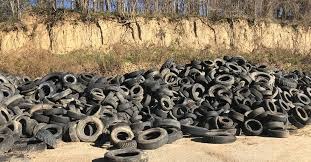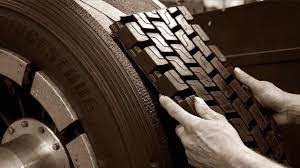Within the ever-evolving realm of waste management, the tire industry stands at a crucial juncture. Conventional approaches such as accumulation and landfilling, retreading, rubber powder production, and harnessing heat energy compete for prominence, juxtaposed with the cutting-edge tire pyrolysis process. See the comparison of different waste tyre treatment methods here.
Waste Tyre Accumulation and Landfilling
- Advantages:
Cost-Effective: Accumulation and landfilling have long been considered cost-effective methods for tire disposal. The simplicity of these processes often translates to lower operational costs.
- Disadvantages:
- Land Resource Depletion: The practice consumes vast land resources, leading to significant land depletion over time.
- Groundwater Contamination: Prolonged accumulation poses the risk of contaminating groundwater, introducing potential hazards to ecosystems.

Rubber Powder Production
- Advantages:
- Versatile Applications: Rubber powder finds use in various industries, including the manufacturing of new tires, asphalt modification, and sports surfaces.
- Waste Reduction: It contributes to waste reduction by recycling tires into valuable granular material.
- Disadvantages:
- Energy-Intensive: The production process can be energy-intensive, impacting its overall environmental footprint.
- Limited Markets: The market for rubber powder is not as expansive as the demand for new tires, potentially limiting economic benefits.
Tyre Retreading
- Advantages:
- Resource Conservation: Retreading extends the life of tires, promoting resource conservation and reducing the demand for new tire production.
- Cost Savings: It often proves more economical than purchasing new tires, providing a financial advantage for businesses and consumers
- Disadvantages:
- Limited Lifespan: While extending tire life, retreading has a finite number of cycles before the tire becomes unusable.
- Safety Concerns: There are concerns about the safety of retreaded tires, as the process involves reusing a tire carcass that has already experienced wear and tear.

Heat Energy Utilization
- Advantages:
- Energy Recovery: Harnessing heat energy from tire combustion can contribute to energy recovery and power generation.
- Reduced Volume: The process reduces tire volume, facilitating easier transportation and storage of the remaining residues.
- Disadvantages:
- Air Pollution: The combustion process releases pollutants into the air, contributing to air pollution and posing health risks.
- Incomplete Resource Recovery: Only a fraction of the tire material is converted into energy, leaving behind residues that still require disposal.
Tire Pyrolysis
- Advantages:
- Resource Valorization: Tyre pyrolysis plant transforms tires into valuable products like pyrolysis oil, carbon black, and steel, maximizing resource recovery.
- Reduced Environmental Impact: Compared to traditional methods, tire pyrolysis significantly reduces the environmental impact, particularly in terms of air and water pollution.
- Circular Economy: It aligns with the principles of a circular economy by creating a closed-loop system, where byproducts are reintegrated into various industries.
- Disadvantages:
- Initial Investment: Establishing pyrolysis plants requires significant initial investment, potentially acting as a barrier for smaller businesses.
- Technical Challenges: The process demands precise control of temperature and residence time, posing technical challenges in maintaining optimal conditions.
Development Trends of Tyre Pyrolysis
- Circular Economy Integration: A notable trend is the increasing integration of tire pyrolysis process into the circular economy model. The byproducts of pyrolysis, including pyrolysis oil and carbon black, are finding diverse applications across industries, contributing to a more sustainable and closed-loop approach.
- Waste-to-Energy Solutions: The rising global emphasis on renewable energy sources is driving the development of tire pyrolysis as a waste-to-energy solution. Pyrolysis plants are evolving to maximize energy recovery, providing an eco-friendly alternative to traditional fossil fuels.
Prospects of Tyre Pyrolysis
- Market Expansion: The tire pyrolysis market is poised for significant expansion as environmental regulations tighten and industries increasingly seek sustainable waste management solutions. This presents a lucrative prospect for businesses involved in the development and operation of pyrolysis plant.
- Advancements in Technology: The future anticipates ongoing technological advancements in the tire pyrolysis field. This encompasses progress in process control, automation, and the investigation of innovative catalysts, all aimed at optimizing the pyrolysis reaction to achieve increased yields and reduced environmental impact.
Strategic Considerations for Sustainable Tire Management
In the intricate web of tire disposal methodologies, each approach comes with its own set of advantages and disadvantages. The choice between accumulation and landfilling, retreading, rubber powder production, heat energy utilization, and tire pyrolysis hinges on a delicate balance of economic considerations, environmental impact, and long-term sustainability.